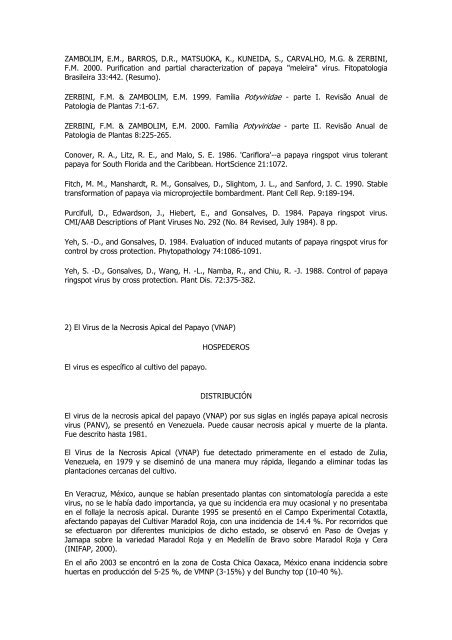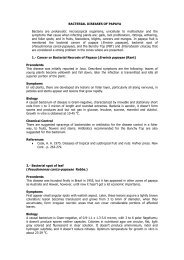clasificación de enfermedades según su agente causal
clasificación de enfermedades según su agente causal
clasificación de enfermedades según su agente causal
Create successful ePaper yourself
Turn your PDF publications into a flip-book with our unique Google optimized e-Paper software.
ZAMBOLIM, E.M., BARROS, D.R., MATSUOKA, K., KUNEIDA, S., CARVALHO, M.G. & ZERBINI,<br />
F.M. 2000. Purification and partial characterization of papaya "meleira" virus. Fitopatologia<br />
Brasileira 33:442. (Re<strong>su</strong>mo).<br />
ZERBINI, F.M. & ZAMBOLIM, E.M. 1999. Família Potyviridae - parte I. Revisão Anual <strong>de</strong><br />
Patologia <strong>de</strong> Plantas 7:1-67.<br />
ZERBINI, F.M. & ZAMBOLIM, E.M. 2000. Família Potyviridae - parte II. Revisão Anual <strong>de</strong><br />
Patologia <strong>de</strong> Plantas 8:225-265.<br />
Conover, R. A., Litz, R. E., and Malo, S. E. 1986. 'Cariflora'--a papaya ringspot virus tolerant<br />
papaya for South Florida and the Caribbean. HortScience 21:1072.<br />
Fitch, M. M., Manshardt, R. M., Gonsalves, D., Slightom, J. L., and Sanford, J. C. 1990. Stable<br />
transformation of papaya via microprojectile bombardment. Plant Cell Rep. 9:189-194.<br />
Purcifull, D., Edwardson, J., Hiebert, E., and Gonsalves, D. 1984. Papaya ringspot virus.<br />
CMI/AAB Descriptions of Plant Viruses No. 292 (No. 84 Revised, July 1984). 8 pp.<br />
Yeh, S. -D., and Gonsalves, D. 1984. Evaluation of induced mutants of papaya ringspot virus for<br />
control by cross protection. Phytopathology 74:1086-1091.<br />
Yeh, S. -D., Gonsalves, D., Wang, H. -L., Namba, R., and Chiu, R. -J. 1988. Control of papaya<br />
ringspot virus by cross protection. Plant Dis. 72:375-382.<br />
2) El Virus <strong>de</strong> la Necrosis Apical <strong>de</strong>l Papayo (VNAP)<br />
El virus es específico al cultivo <strong>de</strong>l papayo.<br />
HOSPEDEROS<br />
DISTRIBUCIÓN<br />
El virus <strong>de</strong> la necrosis apical <strong>de</strong>l papayo (VNAP) por <strong>su</strong>s siglas en inglés papaya apical necrosis<br />
virus (PANV), se presentó en Venezuela. Pue<strong>de</strong> causar necrosis apical y muerte <strong>de</strong> la planta.<br />
Fue <strong>de</strong>scrito hasta 1981.<br />
El Virus <strong>de</strong> la Necrosis Apical (VNAP) fue <strong>de</strong>tectado primeramente en el estado <strong>de</strong> Zulia,<br />
Venezuela, en 1979 y se diseminó <strong>de</strong> una manera muy rápida, llegando a eliminar todas las<br />
plantaciones cercanas <strong>de</strong>l cultivo.<br />
En Veracruz, México, aunque se habían presentado plantas con sintomatología parecida a este<br />
virus, no se le había dado importancia, ya que <strong>su</strong> inci<strong>de</strong>ncia era muy ocasional y no presentaba<br />
en el follaje la necrosis apical. Durante 1995 se presentó en el Campo Experimental Cotaxtla,<br />
afectando papayas <strong>de</strong>l Cultivar Maradol Roja, con una inci<strong>de</strong>ncia <strong>de</strong> 14.4 %. Por recorridos que<br />
se efectuaron por diferentes municipios <strong>de</strong> dicho estado, se observó en Paso <strong>de</strong> Ovejas y<br />
Jamapa sobre la variedad Maradol Roja y en Me<strong>de</strong>llín <strong>de</strong> Bravo sobre Maradol Roja y Cera<br />
(INIFAP, 2000).<br />
En el año 2003 se encontró en la zona <strong>de</strong> Costa Chica Oaxaca, México enana inci<strong>de</strong>ncia sobre<br />
huertas en producción <strong>de</strong>l 5-25 %, <strong>de</strong> VMNP (3-15%) y <strong>de</strong>l Bunchy top (10-40 %).



